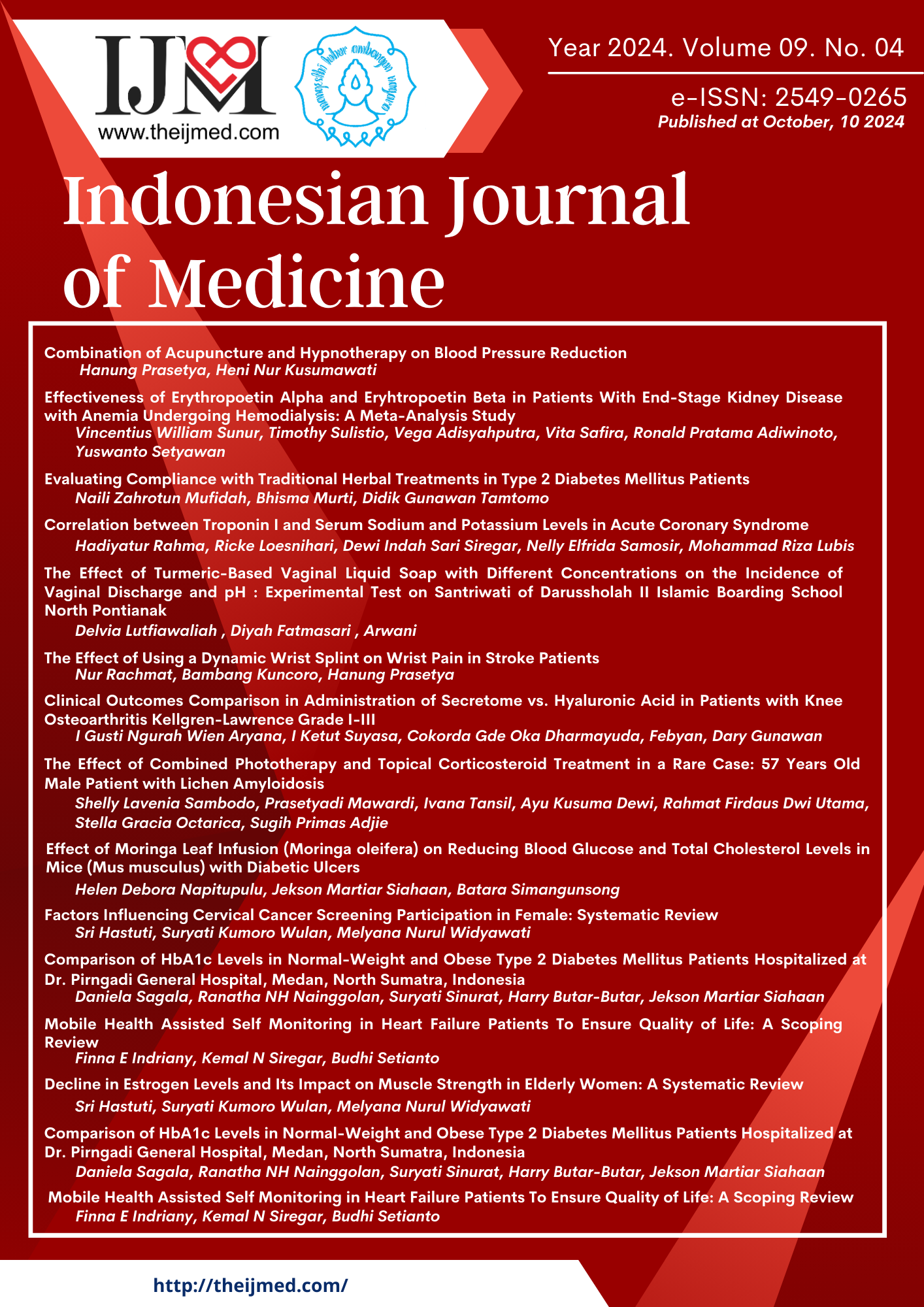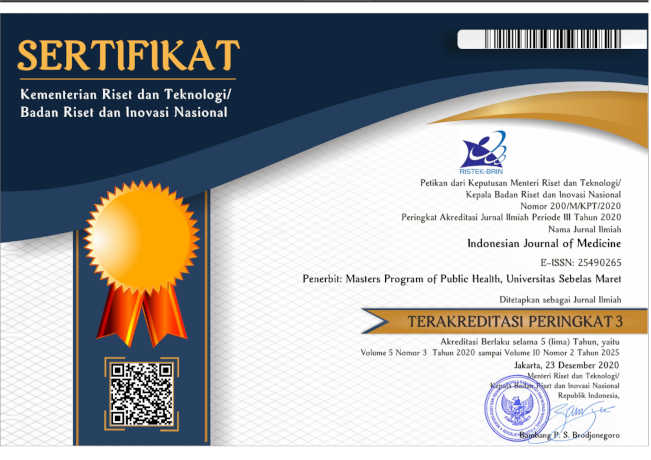Multilevel Analysis of Prognostic Factors for Cognitive Function in Post-Stroke Patients
DOI:
https://doi.org/10.26911/theijmed.2024.9.4.829Abstract
Background: Stroke is the leading cause of disability and the second leading cause of death worldwide. Post-stroke disability can be in the form of motor, sensory, autonomic, or cognitive impairments. Impaired cognitive function is the leading cause of death and pain in post-stroke patients in the world. Decreased cognitive function is present in more than 70% of post-stroke patients and is associated with disability, independence, and pain. This study aims to analyze the prognosis factors of cognitive function in post-stroke patients.
Subjects and Method: This study used a cross-sectional design conducted in 7 hospitals on the island of Lombok from July to August 2024. A total of 200 post-stroke patients were selected using stratified random sampling. The dependent variable in this study was cognitive function examined using the Mini Mental State Examinatio (MMSE) questionnaire. Other independent variables such as age, gender, marital status, pension fund, complications, comorbidities and stroke type were collected using a questionnaire. The data were analyzed using a multilevel double-linear regression model.
Results: The prognosis factor of cognitive function in post-stroke patients was age (b=-0.19; CI 95%=-0.29 to -0.10; p=<0.001), marital status (b=-3.80; CI 95%=-6.72 to -0.88; p=0.011), pension fund (b=-5.88; CI 95%= -8.35 to -3.42; p=<0.001), complications (b=-5.37; CI 95%= -7.34 to -3.39; p=<0.001). While sex, comorbidities, and stroke type did not show a significant relationship with the cognitive function of post-stroke patients. Conversely, there was an influence of doctors treating post-stroke patients on cognitive function (ICC=8.76%).
Conclusion: Age, marital status, pension funds, and complications are prognostic factors in cognitive function of post-stroke patients. Conversely, there is an influence of doctors who treat post-stroke patients on cognitive function.
Keywords:
post-stroke patients, cognitive function, multilevel analysis, prognosis factorsReferences
Abdu S, Satti YC, Payung F, Soputan HA (2022). Analysis of the quality of life of post-stroke patients based on characteristics (Analisis kualitas hidup pasien pasca stroke berdasar-kan karakteristik). JKFN, 5(2), 50–59. Doi: 10.52774/jkfn.v5i2.-107
Akhvlediani T, Gelenidze N, Janelidze T, Gudadze T, Pkhakadze I, Webb A, Katsarava Z (2022). Prevalence of stroke, associated risk factors and stroke related physical, mental, and economic burden in the Republic of Georgia. Eur Stroke J, 7(3), 305–313. Doi:10.1177/23969873221101987
Badan Kebijakan Pembangunan Kesehatan. (2023). Survei Kesehatan Indonesia (SKI).
Boletimi, Reinaldi O, Kembuan MAHN, Pertiwi JM (2021). Cognitive function of post-stroke patients (Fungsi kogn-itif pasien pasca stroke). Medical Scope Journal, 2(2), 66–72. Doi: 10.35790/msj.2.2.2021.32546
Chaurasia RN, Sharma J, Pathak A, Mishra VN, Joshi D (2019). Poststroke cognitive decline: a longitudinal study from a tertiary care center. J Neurosci Rural Pract, 10(3), 459–464. Doi: 10.1055/s-0039-1697872.
Chew SH, Looi I, Neoh KK, Ooi J, Bao MBB, Binti Z, Aziz A, et al. (2021). Clinical outcomes of acute stroke thrombolysis in neurologist and non-neurologist centres – A comparative study in Malaysia. Med J Malaysia, 76(1), 2–6.
Chohan SA, Venkatesh PK, How CH (2019). Long-term complications of stroke and secondary prevention: An overview for primary care physicians. Singapore Med J, 60(12), 616–620. Doi:10.11622/smedj.2019158
Dichgans M (2019). Dementia risk after transient ischaemic attack and stroke. Lancet Neurol, 18(3), 223–225. Doi: 10.1016/S1474-4422(18)30497-6
Dupre ME, Lopes RD (2016). Marital history and survival after stroke. J Am Heart Assoc. 5(12). Doi: 10.1161/-JAHA.116.004647
El Husseini N, Katzan IL, Rost NS, Blake ML, Byun E, Pendlebury ST, Aparicio HJ, et al. (2023). Cognitive impair-ment after ischemic and hemorrhagic stroke: A scientific statement from the american heart association/american stroke asso-ciation. J Am Heart Assoc. 54(6): E272–E291. Doi: 10.1161/STR.000-0000000000430
Filler J, Georgakis MK, Dichgans M (2024). Risk factors for cognitive impairment and dementia after stroke: a systematic review and meta-analysis. The Lancet Healthy Longevity, 5(1): e31–e44. Doi:10.1016/S2666-7568-(23)00217-9
Gall SL, Tran PL, Martin K, Blizzard L, & Srikanth V (2012). Sex differences in long-term outcomes after stroke: Functional outcomes, handicap, and quality of life. Ahajournals, 43(7), 1982–1987. Doi: 10.1161/STROKE-AHA.111.632547
Hafdia ANA, Arman, Alwi MK, Asrina A (2018). Analysis of the quality of life of post-stroke patients at the Polewali Mandar Regency Hospital (Analisis kualitas hidup pasien paska stroke di RSUD Kabupaten Polewali Mandar). Sinergitas Multidisiplin Ilmu Pengetahuan Dan Teknologi, 1(April), 111–118. https://www.jurnal.yapri.-ac.id/-index.php/semnassmipt/article/view/17/17
Huang Y, Wang Q, Zou P, He G, Zeng Y, Yang J (2023). Prevalence and factors influencing cognitive impairment among the older adult stroke survivors: a cross-sectional study. Front. Public Health, 11(September). Doi: 10.3389/fpubh.2023.1254126
Iadecola C, Yaffe K, Biller J, Bratzke LC, Faraci FM, Gorelick PB, Gulati M, Kamel, H, Knopman DS, Launer LJ, Saczynski JS, Seshadri S, Al Hazzouri AZ (2016). Impact of Hypertension on Cognitive Function: A Scientific Statement from the American Heart Association. Ahajournals, 68(6), e67–e94. Doi: 10.1161/HYP.0000000000000053.
Kaddumukasa MN, Kaddumukasa M, Katabira E, Sewankambo N, Namujju LD, Goldstein LB (2023). Prevalence and predictors of post-stroke cogni-tive impairment among stroke sur-vivors in Uganda. BMC Neurol, 23(1), 1–8. Doi: 10.1186/s12883-023-03212-8.
Kamel H, Okin PM, Elkind MSV, Iadecola C (2017). Atrial Fibrillation and Mechanisms of Stroke: Time for a New Model. Ahajournals, 176(1), 100–106. Doi:10.1177/0022146515594631
Lisabeth LD, Brown DL, Hughes R, Majer-sik JJ, Morgenstern LB (2009). Acute stroke symptoms: Comparing women and men. Ahajournals, 40(6), 2031–2036. Doi: 10.1161/STROKE-AHA.109.546812.
Malik A, Maulina M (2019). Fungsi kognitif pasien stroke berdasarkan Mini Mental State Examination (MMSE) di Rumah Sakit Umum Cut Meutia Kabupaten Aceh Utara. Temu Ilmiah: Konsep Mutakhir Tatalaksana Berbagai Persoalan Medis. 169–181.
Merriman NA, Sexton E, McCabe G, Walsh ME, Rohde D, Gorman A, Jeffares I, et al. (2019). Addressing cognitive impairment following stroke: Syste-matic review and meta-analysis of non-randomised controlled studies of psychological interventions. BMJ Open, 9(2), 1–10. Doi: 10.1136/bmj-open-2018-024429
Mosenzon O, Cheng AYY, Rabinstein AA, Sacco S (2023). Diabetes and Stroke: What Are the Connections? J Stroke, 25(1), 26–38. Doi: 10.5853/jos.2022.-02306
Nouh A, Amin-Hanjani S, Furie KL, Kernan WN, Olson DM, Testai FD, Alberts MJ, et al. (2022). Identifying best practices to improve evaluation and management of in-hospital stroke : A scientific statement from the American heart. Ahajournals, April. Doi: 10.1161/STR.0000000000000402
Phan HT, Gall SL, Blizzard CL, Lannin NA, Thrift AG, Anderson CS, Kim J, et al. (2019). Sex Differences in Care and Long-Term Mortality after Stroke: Australian Stroke Clinical Registry. J. Women’s Health, 28(5), 712–720. Doi:10.1089/jwh.2018.7171
Ramadhani SS, Hutagalung HS (2020). The Relationship between Ischemic Stroke and Cognitive Function Disorders at the University of North Sumatra Hospital (Hubungan Stroke Iskemik dengan Gangguan Fungsi Kognitif di RS Universitas Sumatera Utara). SCRIPTA SCORE Sci Med J, 2(1), 20–27. Doi: 10.32734/scripta.v2i1.3373.
Rost NS, Brodtmann A, Pase MP, van Veluw SJ, Biffi A, Duering M, Hinman JD, et al. (2022). Post-stroke cognitive impairment and dementia. Circ Res, 130(8), 1252–1271. Doi: .1161/CIRCRESAHA.122.319951.
Tan KS, Venketasubramanian N (2022). Stroke Burden in Malaysia. Cerebro-vasc Dis Extra, 58–62. Doi: 10.1159/-000524271.
Tian J, Wang Q, Guo S, Zhao X (2024). Association of socioeconomic status and poststroke cognitive function: A systematic review and meta‐analysis. Int J Geriatr Psychiatry. 39. https://api.semanticscholar.org/CorpusID:268855460
Utami S, Wicaksono EN, Choirunnisa A, Veibiani NA, Murti B (2024). Effects of Hypertension, Diabetes Mellitus, and Gender on Post Stroke Cognitive Impairment: Meta-Analysis. J Epide-miol Public Health, 9(1), 68–82. Doi: 10.26911/jepublichealth.-2024.09.-01.07.
van Tuijl JH, van Raak EPM, van Oosten-brugge RJ, Aldenkamp AP, Rouhl RPW (2020). Cognition and quality of life in patients with poststroke epilepsy: A case-control study. Epilepsy Behav, 104, 106444. Doi:10.1016/j.yebeh.2019.106444.
Venketasubramanian N, Yudiarto FL, Tugasworo D (2022b). Stroke Burden and Stroke Services in Indonesia. Cerebrovasc Dis Extra. 12(1): 53–57. Doi:10.1159/000524161
World Health Organization (WHO) (2022). World Stroke Day 2022. World Health Organization. https://www.who.int/srilanka/news/detail/2910-2022-world-stroke-day-2022#:~:text-=The purpose of the World,on stroke around the world.











